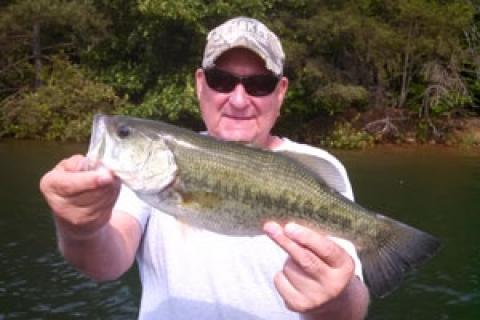
 One of the strongest associations in fishing is that of largemouth bass and weeds. No doubt, flippin' jigs and Texas-rigged plastics will haul green bass out of submerged weedy cover. But in some situations it's often more productive to fish over the tops of the weeds and coax them out. And a soft plastic jerkbait like the venerable Zoom Super Fluke is a good choice to do so.
One of the strongest associations in fishing is that of largemouth bass and weeds. No doubt, flippin' jigs and Texas-rigged plastics will haul green bass out of submerged weedy cover. But in some situations it's often more productive to fish over the tops of the weeds and coax them out. And a soft plastic jerkbait like the venerable Zoom Super Fluke is a good choice to do so.
Perhaps the best scenario for this approach is on clear water lakes. For one, due to the depth (weeds grow deep thanks to the extreme light penetration in the clear water) the upper tips of stalks of coontail, milfoil and pondweed often end below the water's surface. This is especially true along the outer fringe of the weeds, where the weeds are in deeper water. This provides a "clean" zone that's perfect for working a soft jerkbait. Also, a bass can see a greater distance in clear water, i.e. it has a larger strike zone so odds are better that it will move several feet to take a lure.
Here are a few tips and items to consider when fishing soft jerkbaits over weeds for late summer largemouths:
- Hold the boat about a cast's length from the outside edge of the vegetation. Oftentimes there will be weeds up to the surface closer to shore, in shallower water. These mats are often the "tip of the iceberg." Deeper weeds frequently exist in deeper water, visible with good polarized sunglasses, or evident on the sonar unit.
- Don't add any additional weight to the soft jerkbait. The tips of the weeds aren't far below the surface, and you want to be able to work the bait slowly without it constantly contacting stringy vegetation.
- A good hook option is Gamakatsu's EWG in a 2/0 or 3/0 size for a 5-inch soft jerkbait. The hook nestles nicely in the bait's hook slot, providing a streamlined profile. Along with the salt impregnation of the bait, the hook provides just enough weight to give the bait an ultra-slow descent when paused.
- Work the bait with a slow twitch/pause cadence. The twitch grabs the bass's attention; the pause allows it to slowly flutter down, just like an injured minnow.
- Bass will hold on to a soft plastic jerkbait, so you need not set the hook the instant you suspect a bite. When I'm twitching a bait over weed tops and feel resistance, I will typically tighten up just a bit to determine if it's a bass or a weed clump. If the tell-tale tap indicates the former, I can then reel down and set the hook.
- The use of a soft jerkbait over the weed tops should be just a part of your approach when working submerged weed cover. Use jigs and rigs (like Texas, Carolina or Drop shot) to work the depths. But include the jerkbait to catch those often bypassed bass that are looking up.
- 4248 views

